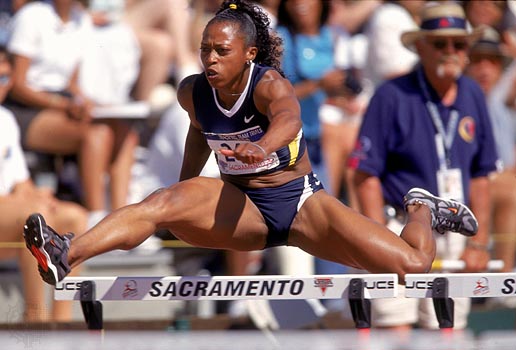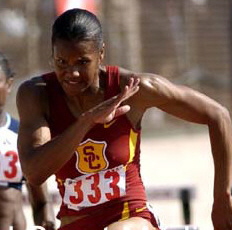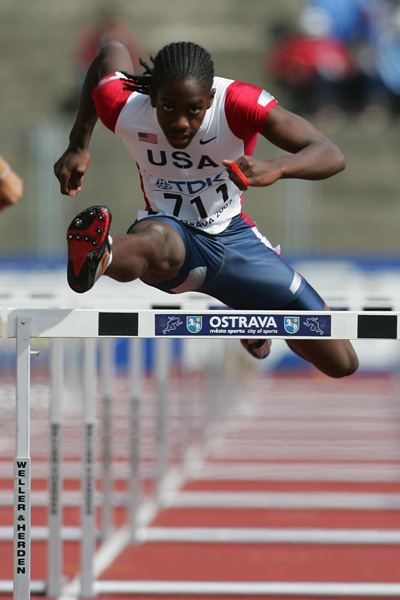The common perception among those who don’t follow the hurdles closely is that taller hurdlers make for better hurdlers. While this is true to an extent, there are exceptions. While it’s easier to teach a taller hurdler to 3-step in the sprint hurdles and they can more easily swallow up ground in the long hurdles, there is a place in the sport for shorter hurdlers, and sometimes that place is at the head of the pack.
Let’s be honest, hurdling is easier if you’re taller, and it is possible to be too small. I would say that in the men’s high hurdles, 5-9 is about as small as you can be and still have a chance to be an elite hurdler. Anything smaller than that, and there’s just too much vertical involved in getting over each barrier. In the women’s race, with the hurdles being only 33 inches (yes, I’m still griping about that), height isn’t nearly as much of an issue. If you have the sprinting speed, then you’ve gotta almost be a midget to be too small.


Gail Devers at 5-2, and Ginny Powell at 5-9, are two of the greatest hurdlers ever.
For the men, it seems that the many of the best hurdlers have fallen somewhere in the 5-10 – 6-1 range. Allen Johnson, Roger Kingdom, Renaldo Nehemiah, Rodney Milburn, and Willie Davenport all fell within that range. Greg Foster, at 6-3, is the only one of those considered to among the greatest ever to be stand taller than 6-2. Why is that? To put it simply, taller hurdlers have more trouble finding room to sprint between the hurdles. As great as Foster was, he had much trouble in that area, to the point where he was just as well-known for crashing into hurdles as he was for winning races.
There’s a hurdler I’ve worked with a little bit named Hector Cotto who runs for Puerto Rico internationally but ran for East Carolina University collegiately. At 6-4, Hector has the same problems that Foster had. And it starts at the first hurdle. Hector tries to sprint like a sprinter, with high knee lift and full range of motion with the arms. Running that way, he’s always taking off too close to the hurdle. His personal best is in the 13.7 range, and he’s a hell of an athlete. His inability to adapt his speed to his height is the biggest reason he hasn’t run faster.
What about Liu Xiang? you might ask. Well that’s a very good question. At 6-2, Xiang should be crashing into hurdles too, but he’s one of the cleanest hurdlers in history. To me, the phenomenon that is Liu Xiang can’t be explained in strictly technical terms. He has an ability to dance between the hurdles that is downright unnatural for someone so tall. But to use technical language, I would have to say this: Because Xiang has good speed, but not blazing speed, his height doesn’t get him too crowded between the hurdles. And by doing enough reps in training, he has mastered the difficult art of balancing his speed with his height.
So, although most elite hurdlers are 6-0 or so, I would say that the larger masses of 110 hurdlers at the collegiate and post-collegiate level are probably more in the 6-1 to 6-4 range. Shoot, I remember when I was in college in the late ‘80s, running in a DIII conference, lining up for the conference final and being the smallest hurdler on the starting line. And I’m 6 feet even. Nowadays you got guys like Dayron Robles, David Oliver, and Aries Merritt among the world’s best, and they’re all 6-1 or taller. So maybe the trend is shifting away from the smaller and medium-sized guys. We’ll see.
Even at the high school level, the hurdlers seem to be getting taller every year. Wayne Davis, one of the kids I coach in youth track, was 5-8 when he first started running over 39’s as a freshman two years ago. This past year he was 5-9 for most of the year, and is probably closer to 5-10 now. But Wayne was the smallest hurdler in every meet he went to. I swear, there are some big cats out there now at the high school level. Some of these guys look big enough to be lining up opposite Ray Lewis or Julius Peppers, not opposite a lane of hurdles. But Wayne is never intimidated, and he always does well against them.
Wayne tells me stories of warming up before big races, and the other hurdlers would be asking “Who’s Wayne Davis? Where’s Wayne Davis?” When Wayne would pipe up and say “I’m Wayne Davis,” they’d look at him in disbelief and say, “You?” After he won his first-round race at the Nike Outdoor Nationals this past June, I overheard one of the guys in his heat say to one of the others as they were walking off the track, “that little n*gga’s fast.”

Little guys like Wayne Davis have to rely on their technique.
As the above anecdote shows, the surprise factor does help the smaller hurdler. When a taller hurdler sees a smaller one, his first thought is, “that little guy can’t beat me,” no matter how fast the smaller guy has run in the past. But the surprise factor only works once. Once they know who you are, you can’t sneak up on anybody. I think the biggest advantage that smaller hurdlers have (although the example of Xiang admittedly refutes this theory) is that they are usually better technicians. They have to be, because their margin for error is smaller. Taller hurdlers have the advantage of looking down on the hurdles, so their height allows them to get away with more technical flaws.
When I interviewed former Olympian Tonie Campbell a while back, he mentioned the possibility of there one day being a hurdler who could alternate lead legs and two-step a 110 race. Interesting thought. Someone 6-7 or 6-8 with good speed and an aggressive mindset two-stepping down the track. That would change everything.
I think it’s important for each athlete to live in the body you’ve been given. Don’t wish to be taller, don’t wish to be faster. I’ll never tell an athlete of mine that he or she is too small to hurdle. But I will be realistic in giving the athlete useful advice in how to adapt his or her technique to his or her body type. If height creates limitations, I will point out those limitations, and provide suggestions and training methods to overcome them. I’ve said it before and I’ll say it again: when a coach and and athlete believe in each other, anything is possible.
© 2007 Steve McGill
